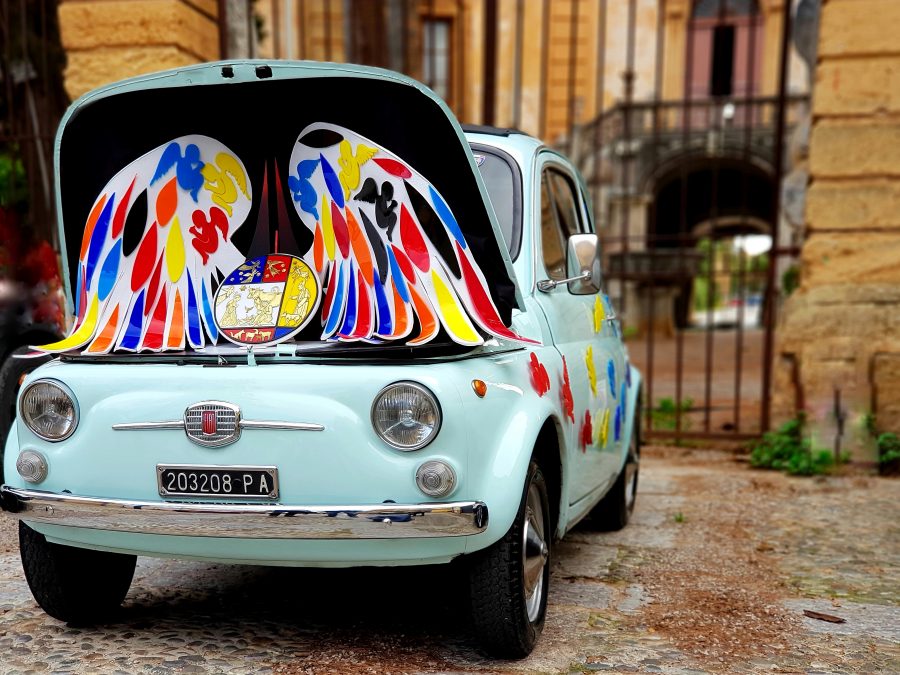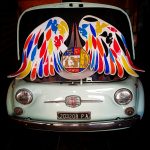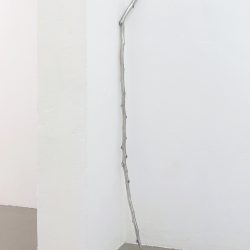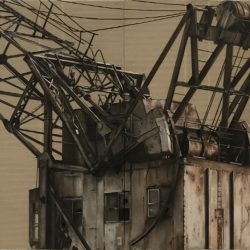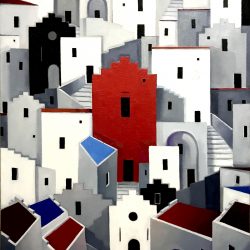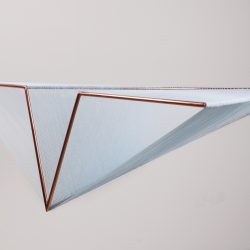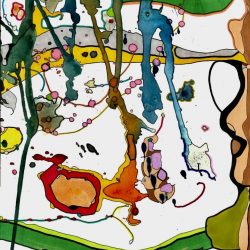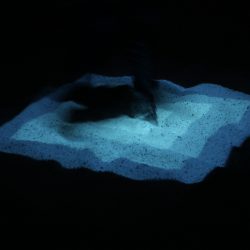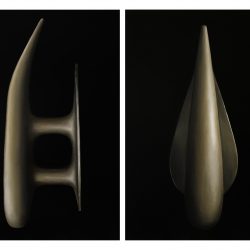work
presepio in movimento
| category | Installation |
| subject | Travels |
| tags | |
| base | 130 cm |
| height | 60 cm |
| depth | 50 cm |
| year | 2019 |
The birth of every work of art is its continuity ...
in a belief, in a path, in a propulsive engine that is always of a spiritual nature ... and here it is not difficult to understand the reason for the creation of a crib in a cult car of Italian design, such as the 500. Art in its essence should not be described, but felt in a timeless time, like the life of a child who is always alive, who despite today's frenzy invites us to stop, to decide which is the way to go in life. As with every faith, it is in the eyes of the observer of the artistic work to welcome the meaning of a story, perhaps always the same, but capable of arousing ever new emotions. The free interpretation of a human creation, which contemplates God's creation, this as a sense of the task of a contemporary artist and designer such as Carmelo Maria Carollo from Bagheria, who began his search for a reworking of traditional nativity scene iconography as early as 2009. I his micro nativity scenes with a diameter of 10 cm are a combination of Plexiglas and precious metal, they stand out for their innovative representation of the nativity, processing of materials and sometimes conceptual symbolisms.
The research of C.M. Carollo, initially focuses on the study of more classical expressive forms of the nativity such as those of Giotto, later on he dedicates himself to the reworking of the camouflaged sacred of great artists such as Giorgio de Chirico and his metaphysics, Cornelis Mondriaan and his neoplasticism, Pablo Picasso and his cubist revolution in contemporary art finally reaches an almost graphic interpretation and geometries similar to POPART, giving the observer a completely new vision of the world of the nativity scene. A detachment from the concept of painting or sculpture in traditional sacred art linked to the nativity becomes fundamental for the artist and designer, with the use of plastic materials on one side and metals on the other, the human hand that forges and shapes , making joy (jewel) even a hard material through a charitable vision and Christian faith based on love, not only in the context of the birth of a life like that of Jesus, but also towards the love of an ideal and love for the life.
Some of the micro nativity scenes by C.M. Carollo have already been the subject of a gift to Pope Francis, who appreciated their representative uniqueness.
C.M. Carollo therefore welcomes Pope Francis' appeal to artists through his works.
“The gifts you have received are a responsibility and a mission for each of you. Gifts and talents are not to be used in the pursuit of vain glory or easy popularity. You are called, through your gifts, drawing from the spiritual source, to propose an alternative way of understanding the quality of life, and to encourage a prophetic lifestyle, capable of deeply rejoicing without being obsessed with consumption, artists are called to create of oasis of beauty, in our cities. YOU ARE CALLED TO KNOW THE FREEDOM OF BEAUTY. " POPE FRANCESCO
The base of the crib is in forex (PVC plastic material) painted black, the non-color of chaos, but at the same time of the density of universal matter, representation of the apparent conclusion of a vital phase from which the sacred work will come to life and the nativity. From this base emerges a volcano (Mount Etna), which symbolizes the indomitable and marvel of divine creation, and from whose sacred fire an explosion of life will be born, infinite pure and winged creatures, which will be scattered along and on the car. The background of the crib is made up of two angel wings (in white painted forex), a reminder of the Annunciation of the Lord. The end flaps are bent in heat, on which abstract colored plexiglass feathers have been applied with hot glue, the latter are intended to be a symbol of the Advent of the incarnation of the divine. The wings therefore represent a sort of landing that took place, bringing with them the joy of a world of primary colors, and symbolizing the essence of the Christian message linked to the nativity, referring to Mondriaan's search for harmony and neoplastic balance and to the main scene. On the central scene, a crib made of Plexiglas and brass, with a diameter of 35 cm, depicting in various sections, the traditional elements of the crib and the image of Pope Francis. The circular choice of the nativity scene is linked to the symbol of the body of Christ and his resurrection in the form of light. On the hatbox, on the other hand, you can see a micro nativity scene on a blue background, inspired by Picasso, supported by two angelic figures, one male and one female, naked and pure without sin in love, who together hold in their hands the extreme ideal "AMOR VINCIT OMNIA ET NOS CEDAMUS AMORI ”(Love wins everything, let us surrender to love too.) A work of art always has a life of its own, which borders on logos, poetry and philosophy. The object comes to life from the moment the observer grasps the mystery of elements that cannot be explained in words, but perceived as meaning. The moving nativity scene, in which a change of direction towards the love of God, represents the divine part that has survived in human beings.
in a belief, in a path, in a propulsive engine that is always of a spiritual nature ... and here it is not difficult to understand the reason for the creation of a crib in a cult car of Italian design, such as the 500. Art in its essence should not be described, but felt in a timeless time, like the life of a child who is always alive, who despite today's frenzy invites us to stop, to decide which is the way to go in life. As with every faith, it is in the eyes of the observer of the artistic work to welcome the meaning of a story, perhaps always the same, but capable of arousing ever new emotions. The free interpretation of a human creation, which contemplates God's creation, this as a sense of the task of a contemporary artist and designer such as Carmelo Maria Carollo from Bagheria, who began his search for a reworking of traditional nativity scene iconography as early as 2009. I his micro nativity scenes with a diameter of 10 cm are a combination of Plexiglas and precious metal, they stand out for their innovative representation of the nativity, processing of materials and sometimes conceptual symbolisms.
The research of C.M. Carollo, initially focuses on the study of more classical expressive forms of the nativity such as those of Giotto, later on he dedicates himself to the reworking of the camouflaged sacred of great artists such as Giorgio de Chirico and his metaphysics, Cornelis Mondriaan and his neoplasticism, Pablo Picasso and his cubist revolution in contemporary art finally reaches an almost graphic interpretation and geometries similar to POPART, giving the observer a completely new vision of the world of the nativity scene. A detachment from the concept of painting or sculpture in traditional sacred art linked to the nativity becomes fundamental for the artist and designer, with the use of plastic materials on one side and metals on the other, the human hand that forges and shapes , making joy (jewel) even a hard material through a charitable vision and Christian faith based on love, not only in the context of the birth of a life like that of Jesus, but also towards the love of an ideal and love for the life.
Some of the micro nativity scenes by C.M. Carollo have already been the subject of a gift to Pope Francis, who appreciated their representative uniqueness.
C.M. Carollo therefore welcomes Pope Francis' appeal to artists through his works.
“The gifts you have received are a responsibility and a mission for each of you. Gifts and talents are not to be used in the pursuit of vain glory or easy popularity. You are called, through your gifts, drawing from the spiritual source, to propose an alternative way of understanding the quality of life, and to encourage a prophetic lifestyle, capable of deeply rejoicing without being obsessed with consumption, artists are called to create of oasis of beauty, in our cities. YOU ARE CALLED TO KNOW THE FREEDOM OF BEAUTY. " POPE FRANCESCO
The base of the crib is in forex (PVC plastic material) painted black, the non-color of chaos, but at the same time of the density of universal matter, representation of the apparent conclusion of a vital phase from which the sacred work will come to life and the nativity. From this base emerges a volcano (Mount Etna), which symbolizes the indomitable and marvel of divine creation, and from whose sacred fire an explosion of life will be born, infinite pure and winged creatures, which will be scattered along and on the car. The background of the crib is made up of two angel wings (in white painted forex), a reminder of the Annunciation of the Lord. The end flaps are bent in heat, on which abstract colored plexiglass feathers have been applied with hot glue, the latter are intended to be a symbol of the Advent of the incarnation of the divine. The wings therefore represent a sort of landing that took place, bringing with them the joy of a world of primary colors, and symbolizing the essence of the Christian message linked to the nativity, referring to Mondriaan's search for harmony and neoplastic balance and to the main scene. On the central scene, a crib made of Plexiglas and brass, with a diameter of 35 cm, depicting in various sections, the traditional elements of the crib and the image of Pope Francis. The circular choice of the nativity scene is linked to the symbol of the body of Christ and his resurrection in the form of light. On the hatbox, on the other hand, you can see a micro nativity scene on a blue background, inspired by Picasso, supported by two angelic figures, one male and one female, naked and pure without sin in love, who together hold in their hands the extreme ideal "AMOR VINCIT OMNIA ET NOS CEDAMUS AMORI ”(Love wins everything, let us surrender to love too.) A work of art always has a life of its own, which borders on logos, poetry and philosophy. The object comes to life from the moment the observer grasps the mystery of elements that cannot be explained in words, but perceived as meaning. The moving nativity scene, in which a change of direction towards the love of God, represents the divine part that has survived in human beings.



